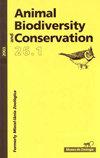Comparison of nestling diet between first and second broods of great tits Parus major in urban and forest habitats
IF 1
4区 环境科学与生态学
Q3 BIODIVERSITY CONSERVATION
引用次数: 0
Abstract
To understand why early broods tend to be more successful than late broods we investigated the nestling diet and reproductive success of great tit pairs that had both a first and a second brood in the same breeding season. We found that in forest habitats great tit parents delivered similar composition and amount of food per nestlings throughout the breeding season, resulting in similar nestling body mass and survival in both first and second broods. In urban habitats, however, although parents provided similar amounts of food to the second broods they tended to deliver fewer caterpillars. In parallel with this, we observed lower nestling survival in second urban broods than in first broods even though the body mass of surviving nestlings was similar to that of the first broods. These findings suggest that although parents produce smaller second broods in both habitats, they are able to compensate for lower food availability in forest habitats but not in urban habitats, thus leading to reduced food quality and lower offspring survival in urban second broods.城市和森林生境大山雀一、二巢雏鸟食性比较
为了理解为什么早孵的比晚孵的更成功,我们调查了在同一繁殖季节有第一窝和第二窝的大山雀对的雏鸟饮食和繁殖成功率。我们发现,在森林栖息地,在整个繁殖季节,大山雀父母给每只雏鸟提供的食物成分和数量相似,导致第一窝和第二窝的雏鸟体重和存活率相似。然而,在城市栖息地,尽管父母为第二窝提供了相同数量的食物,但它们往往产下更少的幼虫。与此同时,我们观察到,尽管幸存的雏鸟的体重与第一窝相似,但第二窝的雏鸟存活率比第一窝要低。这些发现表明,尽管在这两种栖息地中,父母都能产生较小的第二窝,但它们能够弥补森林栖息地食物供应不足的不足,而在城市栖息地则无法弥补,从而导致城市第二窝食物质量下降和后代存活率降低。
本文章由计算机程序翻译,如有差异,请以英文原文为准。
求助全文
约1分钟内获得全文
求助全文
来源期刊

Animal Biodiversity and Conservation
农林科学-动物学
CiteScore
2.00
自引率
0.00%
发文量
21
审稿时长
>12 weeks
期刊介绍:
Animal Biodiversity and Conservation (antes Miscel·lània Zoològica) es una revista interdisciplinar, publicada desde 1958 por el Museu de Ciències Naturals de Barcelona. Incluye artículos de investigación empírica y teórica en todas las áreas de la zoología (sistemática, taxonomía, morfología, biogeografía, ecología, etología, fisiología y genética) procedentes de todas las regiones del mundo. La revista presta especial interés a los estudios que planteen un problema nuevo o introduzcan un tema nuevo, con hipòtesis y prediccions claras, y a los trabajos que de una manera u otra tengan relevancia en la biología de la conservación. No se publicaran artículos puramente descriptivos, o artículos faunísticos o corológicos en los que se describa la distribución en el espacio o en el tiempo de los organismes zoológicos.
 求助内容:
求助内容: 应助结果提醒方式:
应助结果提醒方式:


